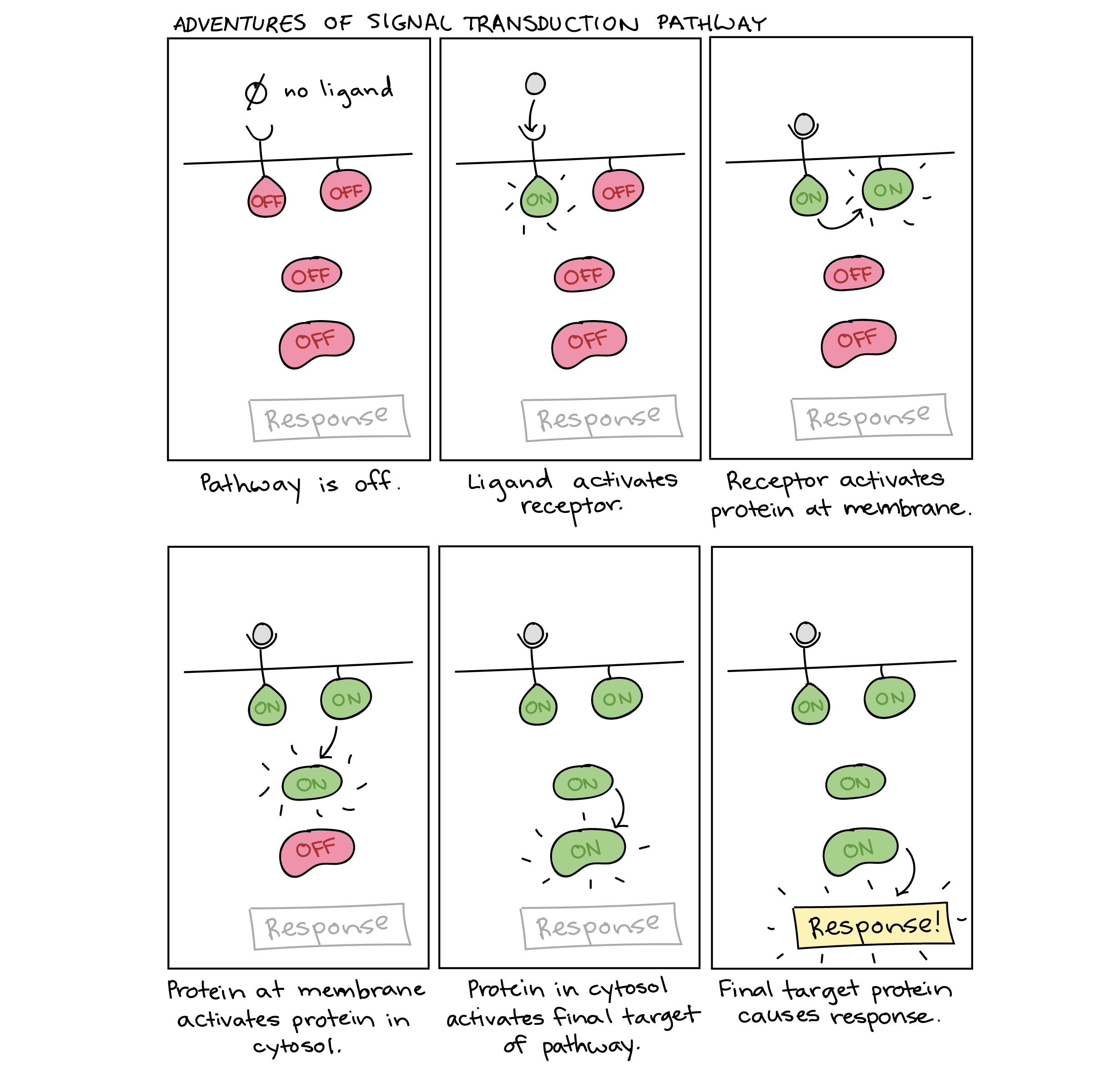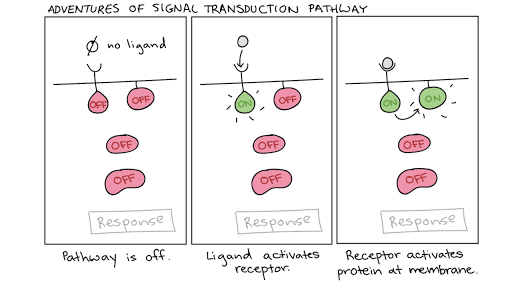Active Signal Transduction Can Modify Which of the Following
Working Its Types. A signaling molecule reaches its target cell and binds to a specific receptorThis activates a signaling cascade involving intracellular enzymes and molecules second messengers which again leads to a specific reactionVia signal amplification the number of signaling molecules is.

Signal Transduction Pathway Cell Signaling Article Khan Academy
Competitive inhibitors literally block the active site.

. 3 signal released from source. A mechanism to stop the activation of the pathway. The main function of this is to change a physical quantity to an equivalent electrical signal.
During signal transduction a the cell converts an extracellular signal into an intracellular signal that leads to a change in some cell process b a signaling molecule directly activates or represses several genes c each enzymecatalyzes production of one molecule of product d enzymes in the signal cascade remain active until the last. The molecule must have a signal-binding site on the extracellular side of the membrane and must have an intracellular domain. The model for the action of Epinephrine is shown below.
Mutations within genes coding for G protein-coupled receptors GPCRs can lead to one of two major outcomesa loss-of-function or a gain-of-function. Amplification of the signal. Which of the following is common to all signal transduction pathways.
Loss-of-function mutations prevent signaling in GPCR pathways even in the presence of signaling molecules. Cell signaling can be classified into. Each of the following numbered processes are involved in signal transduction pathways.
Signal transduction pathways link signal reception with cellular responses. 04 marks DM receptor STK. Consider the following signal transduction pathway that is activated by the binding of EGF ligand to its specific membrane receptor.
4 signal transduction A 1234 B 2314 C 3214 D 3241 E none of the above D The major difference between a cell that responds to a signal and one that does not is the presence of a A DNA sequence that binds to the signal. There are many different types of inhibitors and activator molecules that can change how a signal transduction pathway functions including things like insecticides and certain medicines. Receptor kinases play a key role in triggering the signal cascade.
Threonine and tyrosine residues are all subjected to phosphorylation in various signal transduction pathways. Then the receptor protein embedded in the cellular membrane must accept the signal. Terms in this set 8 Which of the following statements regarding signal transduction is true select all that apply.
A cascade of events or biochemical changes within the cell. You can write your answer in a few sentences or modify the diagram directly for your answer. The α subunits close around the insulin molecule.
When a ligand binds to a cell-surface receptor the receptors intracellular domain part inside the cell changes in some way. Signal transmission is caused either by. Although ligand binding to 7TM receptors initiates a signal transduction pathway by triggering a change in tertiary structure another class of receptors involves dimerization upon ligand binding.
The result of this is that a intracellular protein kinase domains are brought together and activate one another by cross-phosphorylation. The signaling molecule binds to a surface receptor. Signal Transduction transmission of molecular signals from outside the cell into the cell via cell-surface receptors.
Binding of acetylcholine to the receptor induces a conformational change that opens a transmembrane pore allowing Na and Ca 2 to flow into. Make sure all parts of the statement are consistent with course concepts before concluding it is true A ligand with a high affinity is more likely to result in signal transduction than a ligand with low affinity. How could you modify the following signal transduction pathway so that the cells response to a new IL interleukin-krab is induction of a pineapple gene as well as the overall gene.
Binding of the ligand to the receptor must induce change into another form transduced that affects the shape of the. There is the primary messenger which may be a chemical signal electrical pulse or even physical stimulation. 2 signal binds to receptor.
All of the following are enzymes involved in the signal. A True b. The transducer is an electrical device.
You are studying the activity of a receptor tyrosine kinase. Binding initiates a signaling pathway. Ligand-bound EGF receptors become active through phosphorylation and become active.
6 Questions Show answers. In signal transduction extracellular signals are converted into intracellular signals. The change in the receptor sets off a series of signaling events.
The input in most of the electrical systems is the electrical signal. Transduction Which of the following represents the sequence of events in a typical signal transduction pathway. Answer the following questions and then press Submit to get your score.
Epinephrine also known as adrenaline or adrenalin is a hormone and a neurotransmitter. Many signal transduction pathways include protein modification and phosphorylation cascades. In fact there are many types of inhibitors that can change the function of an enzyme in a signal transduction pathway.
Active EGF receptor causes Ras to exchange its bound GDP for GTP and become active. EGF ligand binds of the EGF receptor. Transmission of a signal across a membrane barrier.
Upon receiving the signal this protein goes through a conformational change. 1 alteration of cell function. All of the above.
During signal transduction a signal may have many components. O receptors that initiate biochemical changes accomplish this either by intrinsic enzymatic activities within the receptor itself or by activating intracellular messenger. Phosphorylated proteins act with enzymes to trigger the signal cascade.
What is an Active Transducer. Generally it takes on a new shape which may make it active as an enzyme or let it bind other molecules. However a non-electrical signal can be changed into its equivalent electrical signal by using electrical techniques.
Signaling begins with the recognition of a chemical messenger a ligand by a receptor protein in a target cell. In the signal transduction mechanism known as protein phosphorylation. The receptor is activated.

Signal Transduction Pathway Cell Signaling Article Khan Academy

Signal Transduction Pathways Related To Adrenergic Receptor Induced Download Scientific Diagram

Signal Transduction Pathway Cell Signaling Article Khan Academy

No comments for "Active Signal Transduction Can Modify Which of the Following"
Post a Comment